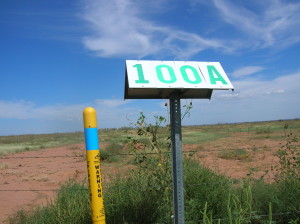*This article is not a substitute for the advice of an attorney.*
A recent jury verdict in Johnson County, Texas illustrates an important point for landowners to understand when it comes to determining compensation for easements taken by eminent domain.
Background
In this case, the landowners owned a 400-plus acre parcel of land within the city limits of Mansfield, Texas, which is about 20 minutes outside of Ft. Worth. Some of the land is commercially zoned and abuts Highway 287, making it prime property for commercial developers. Peregrine Pipeline Co. (“company”) sought to purchase an easement from the landowners for a natural gas pipeline. The easement would be placed in a manner that in order to access much of the Highway 287 frontage, the easement must be crossed. Specifically, the company sought a mile-long, 20 foot wide easement in order to place a 16 inch natural gas pipeline, which equates to about 3 acres of land total. As is common, the company also sought a temporary 55 foot workspace easement while the pipeline was being installed that constituted approximately 8 acres total.
When negotiations were unsuccessful, the company initiated a condemnation proceeding in 2007 to take the easement pursuant to their eminent domain power. The sticking point in the negotiations was the amount of damages, with the company offering total compensation of only $80,000. Upon the filing of the condemnation proceeding, the court-appointed special commissioners found that adequate compensation was $79,979. The landowners, who did not appear at the special commissioner hearing, filed a timely appeal.
Key Issue
The key issue in this case is the proper considerations when calculating compensation. The company argued that compensation should be $80,000, measured by the value of the 20′ strip of land that would be taken for the easement, giving no monetary value to any damage to the remaining land.
The landowners argued that they were entitled to both the value of the actual easement, but should also be compensated for the harm that the easement would do to the remaining land. This is frequently known in the law as “remainder damages.” Specifically, the landowners pointed out that they would not be able to take any action on the easement without first obtaining permission from the company. For example, if the landowners wanted to build a road or parking lot over the easement, such permission would be required, thereby harming the value of the remaining land. In light of this theory, the landowners sought $1.6 million in total damages.
The Verdict
Last month, the Johnson County jury sided with the landowners, ordering an award of $1.6 million. The jury broke the verdict down as follows: $219,126 for the 3 acre permanent easement; $63,464 for the 8 acre temporary work easement; and $1,350,410 in damages to the remainder of the landowner’s property.
Judge Robert Dohoney entered a final verdict for $2.1 million (the original verdict plus court costs and interest). No appeal has been filed yet, but the landowner’s attorney indicated that he believes that the pipeline company will appeal this decision.
Why Does This Matter?
This case is important for all landowners because it indicates that when property is taken for an easement, the compensation due must consider not only the value of the strip of property taken, but also includes monetary impacts on the remaining land. Luke Ellis, attorney for the landowners, explained that although this case did not involve agricultural land, the same issue can arise when dealing with condemnation of farms or ranches. Specifically, all landowners should seek compensation not only for the taking of the easement itself, but for adverse impacts that will have on the remaining property including the loss of the right to exclude others from coming and going on private property, the loss of development potential, and any onerous terms that are imposed on the landowner by the easement agreement.
More Information
For more information on this jury verdict you may access articles here, here, and here.













